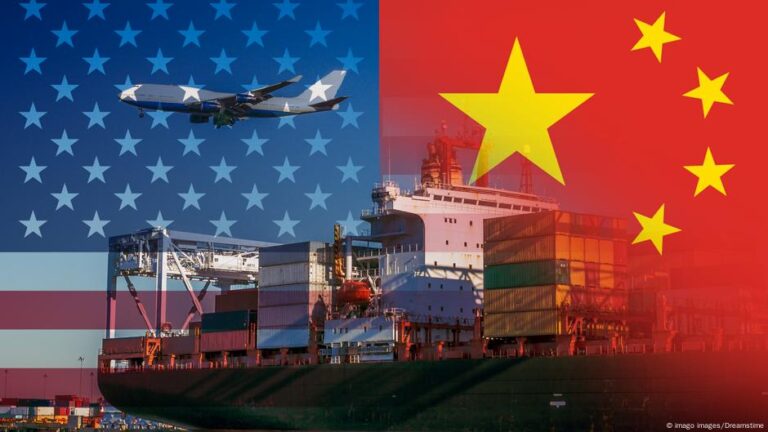A recent picture that’s gone viral in the United States captures the prevailing mood among Americans: a clear plastic bag containing an American flag, labeled “Made in China.”
For supporters of US President Donald Trump, it’s proof that something is deeply wrong with the US economy. They’ve called on “patriots” to boycott Chinese goods.
But can America really afford to cut ties? Is the free flow of mutually traded goods like rare earths, smartphones, soybeans and microchips at risk of becoming a victim of the fight for geopolitical dominance?
Deep economic ties
Were all trade between the two world powers to cease, experts say the US economy would struggle more than Chinese economy. Scott Kennedy of the Center for Strategic & International Studies (CSIS) in Washington D.C. said the mutual dependence of both sides “remains quite high.”
“Despite economic security concerns, both sides still gain significantly from trade,” he told DW.
However, the US-China trade gap is quite significant. Over the past decade, the US trade deficit with China has widened from $295 billion (€252 billion) to $382 billion. In 2024, China exported goods worth $526 billion to the US — more than triple what it imported.
Chinese products are part of everyday life in America. Of those imports, $127 billion were smartphones and computers. Any new tariffs would hit US consumers directly.
Of tariffs and counter-tariffs
Trump’s 100% tariffs have angered Beijing, but unlike Europe, China is responding with defiance. Government officials in Beijing have vowed to “fight to the end” and urged Washington to “correct its approach,” warning in an October 13 statement on social media platform X that “threatening high tariffs is not the right way to deal with China.”
Beijing has already retaliated by imposing counter-tariffs and export restrictions, including on the rare-earth minerals critical to electric vehicles, semiconductors and defense technology. The US depends on imports for more than 90% of its rare earth supply — over 80% of which comes from China. Beijing controls about 60% of global rare-earth production and nearly 90% of refining capacity.
The US-China rift extends beyond minerals. Since May, China hasn’t bought a single soybean from the US, according to the US Department of Agriculture. Last year, those exports were worth nearly $13 billion. Now, China buys from Brazil and Argentina instead.
The soybean boycott and rare-earth restrictions are Beijing’s response to Washington’s tightening chip export controls, first imposed in 2022 to curb China’s access to advanced technology and artificial intelligence (AI).
Christina Otte from the German state-run foreign investment agency, Germany Trade & Invest (GTAI), argues the US is likely more dependent on China than the other way around.
“While the US remains a key market for Chinese goods, its importance has steadily declined since Trump’s first term,” she told DW.
New markets, new strategy
According to news agency Bloomberg, China has successfully redirected exports once bound for the US to other regions.
Between September 2024 and September 2025, shipments to Africa rose 56%, the agency reported — to Southeast Asia 16%, to the EU 14%, and to Latin America 15%.
“The US now ranks behind ASEAN [Southeast Asian trade bloc] and roughly on par with the EU,” said Otte. “In the first half of 2025, bilateral trade fell more than 10% year over year.”
Chinese firms are also “expanding production in countries like Vietnam and Malaysia to keep supplying the US market indirectly,” she added.
In addition, China is also cutting financial ties to the heavily indebted US. Its holdings of US Treasury securities have dropped from $1.3 trillion in 2013 to $765 billion this year, according to data from the US Federal Reserve. China now ranks behind Japan and the UK among foreign holders of US debt.
‘Chimerica’ still standing
Despite this slow disengagement, trade remains crucial for the two superpowers.
“China still relies on US supplies in aerospace, high-performance chips and semiconductors,” said Kennedy, adding that Chinese products, in turn, remain deeply embedded in American supply chains.
Chinese President Xi Jinping and Donald Trump are expected to meet later this month at the APEC Summit in Gyeongju, South Korea. Both sides hope to ease tensions before the tariff spiral spins further out of control.
Kennedy is optimistic, stressing that the US-China relationship is “still quite resilient.”
“Chimerica” is the term he uses to describe US-Chinese interdependency, which may be “bruised, but it’s not dead — and it won’t disappear easily.”
This article was originally written in German.


